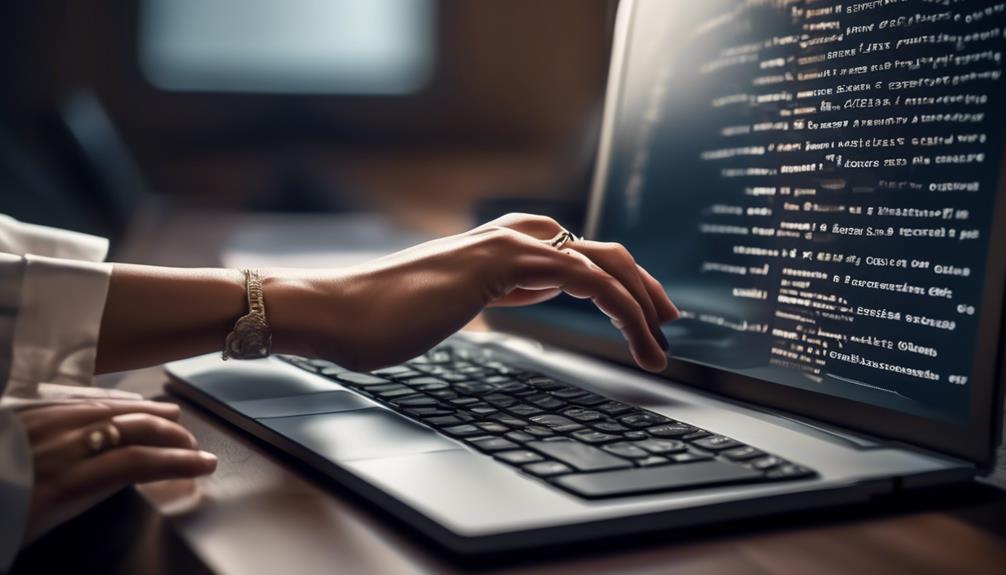When composing an email to an embassy, it’s important to adhere to specific customs and manners that might not be readily apparent. Achieving the proper tone and delivering your message in a clear and respectful manner is essential.
The way you address the embassy and the level of detail you provide can greatly impact the effectiveness of your communication.
In our discussion, we'll explore the key elements that make for a well-crafted email to an embassy, ensuring that your message is received and considered in the best possible light.
Key Takeaways
- Clearly state the purpose of your email in the subject line
- Introduce yourself and state the specific reason for contacting the embassy
- Provide all necessary details related to your request or inquiry
- Conclude the email with a polite and professional tone, expressing gratitude and requesting a prompt response.
Purpose of Your Email
When reaching out to the embassy, clearly stating the purpose of our email in the subject line is essential for prompt attention to our inquiry. This ensures that embassy officials can quickly identify the nature of our communication and prioritize their response.
When writing the email, it's crucial to address the embassy with the appropriate level of formality in the opening greeting. Introducing ourselves and clearly stating the specific reason for contacting the embassy helps set the tone for the rest of the email.
Providing all necessary details related to our request or inquiry is equally important. This includes any relevant personal information, the purpose of our visit or inquiry, and any supporting documentation.
Concluding the email with a polite and professional tone, expressing gratitude for their attention to the matter, and requesting a prompt response shows respect and professionalism.
Addressing the Email

We should begin our email by addressing the embassy staff or ambassador with the appropriate title and formal greeting, ensuring to use the correct salutation and address, such as Dear Sir/Madam or To Whom It May Concern, to start the email. It is essential to research the specific embassy's protocols and formalities for addressing and writing the email. Starting with a formal greeting and addressing the person by their full title shows respect and professionalism. Additionally, it's important to write a subject line that clearly explains the purpose of your email.
When addressing embassy staff or an ambassador in a formal email, it's crucial to use the correct salutation and address. Below is a table that provides examples of formal salutations and addresses for writing an email to embassy staff:
| Salutation | Example Address | Example Greeting |
|---|---|---|
| Ambassador | His/Her Excellency | Dear Ambassador |
| Minister | The Honorable | Dear Minister |
| Counselor | Mr./Ms. | Dear Counselor |
| First Secretary | Mr./Ms. | Dear First Secretary |
| Attaché | Mr./Ms. | Dear Attaché |
Addressing the email in the correct manner sets a positive tone for the communication and demonstrates your understanding of diplomatic etiquette.
Introducing Yourself
Introducing ourselves to the embassy, we respectfully present our purpose and pertinent personal details in a formal and polite tone, expressing gratitude for their attention and assistance.
When writing an email to the embassy to introduce yourself, it's crucial to adhere to formal writing standards to ensure a respectful and professional tone. Here are the key points to consider when introducing yourself in an email to the embassy:
- Clearly state the purpose of your email and provide necessary information about yourself, such as your full name, nationality, and any relevant identification numbers.
- Use a formal and polite tone, addressing the embassy with the appropriate titles and expressing gratitude for their attention and assistance.
- Provide relevant background information, such as your current occupation, educational background, and any affiliations that are pertinent to the reason for contacting the embassy.
- Be clear and concise in your introduction, avoiding unnecessary details while ensuring that all essential information is included to convey your purpose respectfully.
Providing Details

Transitioning from introducing ourselves to the embassy, we now focus on providing essential details tailored to our inquiry in a professional and respectful manner.
When writing an email to an embassy for a visa request, it's crucial to ensure that all information provided is accurate and pertinent to the nature of the inquiry. Start by clearly stating the purpose of the email and provide comprehensive details such as your full name, passport number, and any other specific information required for the visa application. It's imperative to avoid making false or misleading statements and maintain a tone that's formal and courteous throughout the email.
In addition to the necessary personal details, it's essential to summarize the visa request or inquiry in the final paragraph, expressing gratitude for the embassy's time and consideration. Furthermore, don't forget to include your contact information and request a prompt response, adhering to proper email etiquette. This approach ensures that the embassy has all the required details to process the visa request efficiently.
Being Polite and Professional
When addressing the ambassador or staff members in an email to the embassy, it's essential to maintain a formal and polite tone throughout the communication. This ensures that you convey respect and professionalism in your correspondence.
Here are four key points to consider when aiming to be polite and professional in your email to the embassy:
- Use a formal greeting: Begin your email with a respectful salutation, such as 'Dear Ambassador [Last Name]' or 'To Whom It May Concern.' This sets the tone for a courteous and professional exchange.
- Mind your language: Be mindful of the language you use, avoiding slang or overly casual expressions. Keep your tone respectful and professional, demonstrating your understanding of diplomatic etiquette.
- Express gratitude: Whether you're requesting assistance or providing information, it's important to express gratitude for the recipient's time and attention. A simple 'Thank you for your consideration' can go a long way.
- Close with courtesy: End your email with a polite closing, such as 'Sincerely' or 'Best regards,' followed by your full name and contact information.
Frequently Asked Questions
How Do You Start an Email to an Embassy?
We start an email to an embassy by addressing the recipient respectfully and clearly stating the purpose of our letter.
It's important to use a standard word-processing application and a readable font for the letter.
We should also determine the preferred method of delivery and follow any specific instructions provided by the embassy.
Including our contact information and keeping a copy of the letter for our records is also crucial.
How Do You Write a Formal Letter to an Embassy?
We start a formal letter to an embassy by addressing the ambassador or staff member respectfully and clearly stating the purpose of our letter.
We use a standard word-processing application and readable font. We proofread and edit the letter for clarity and accuracy before sending it.
It's important to include our contact information and to follow specific delivery instructions provided by the embassy. Keeping a copy of the letter for our records is also crucial.
How Do I Direct a Letter to an Embassy?
Directing a letter to an embassy demands meticulous attention to detail. Ensure the precise addressing of the department or staff member, display a formal and polite tone, and concisely articulate the purpose with necessary details.
Utilize the correct embassy address format and include your contact information.
Prior to sending, meticulously proofread and edit for clarity and accuracy.
This approach will ensure your letter effectively reaches its intended recipient with professionalism and respect.
How Do I Write an Email to a Visa Officer?
We write emails to visa officers by addressing them respectfully, clearly stating our purpose, and providing all necessary information.
It's important to use a readable font and standard word-processing application for the letter. Also, we should proofread and edit the email for clarity and accuracy before sending it.
Lastly, we must determine the preferred method of delivery and follow any specific instructions provided by the embassy.
Conclusion
So, next time you need to write an email to an embassy, remember to keep it professional and respectful.
After all, isn't it important to make a good impression when reaching out to such an important institution?










